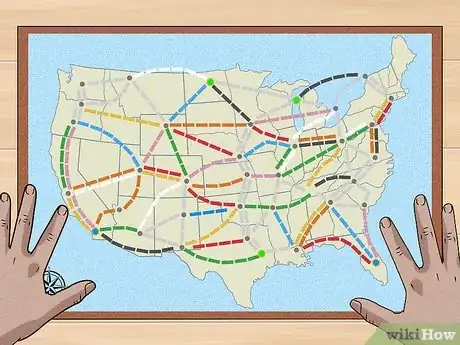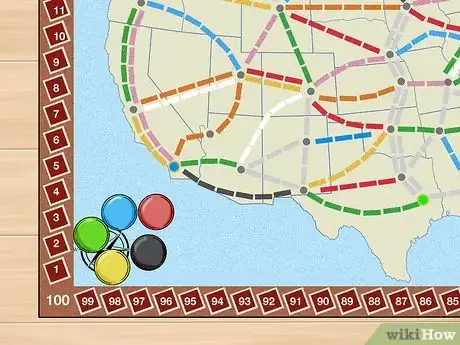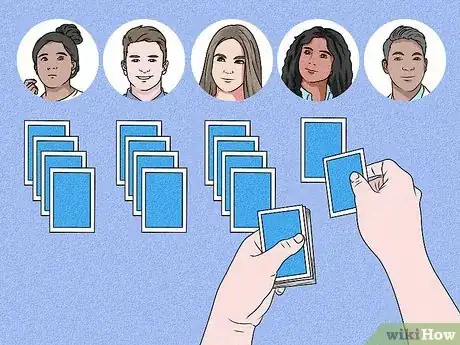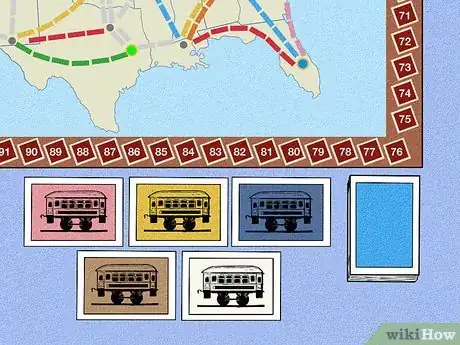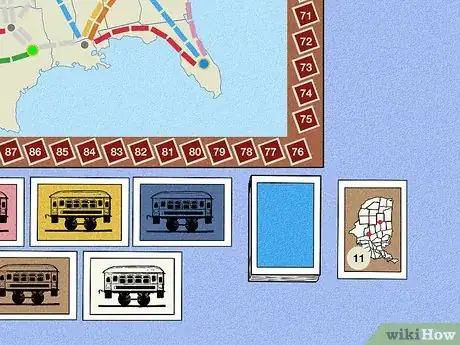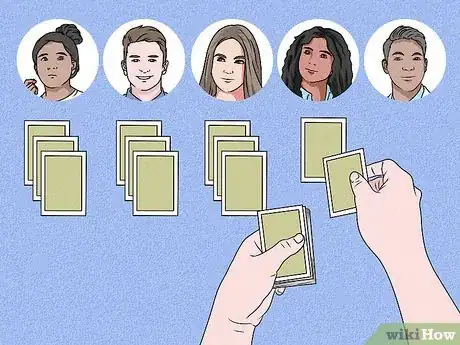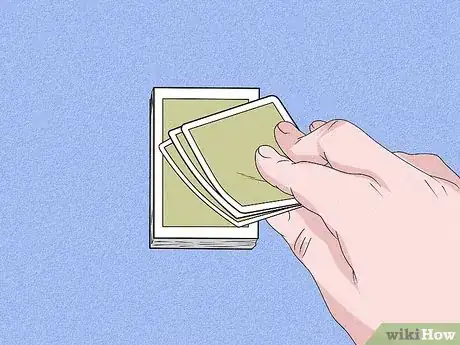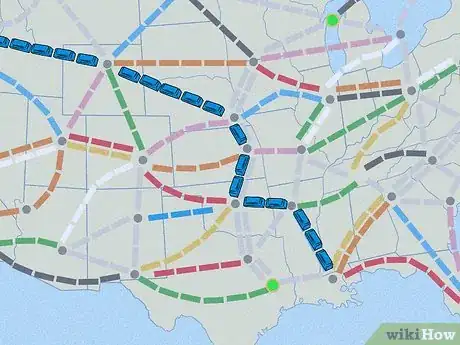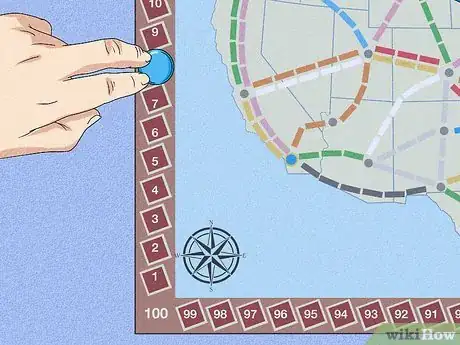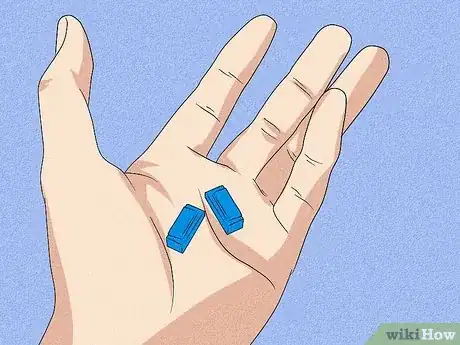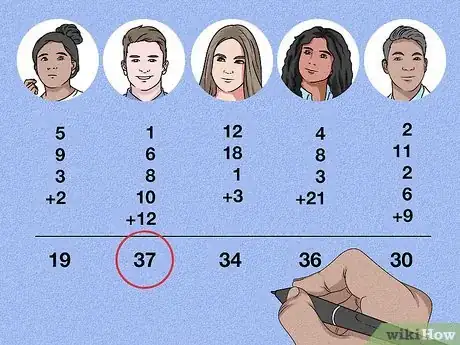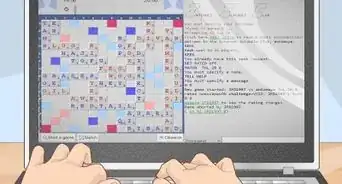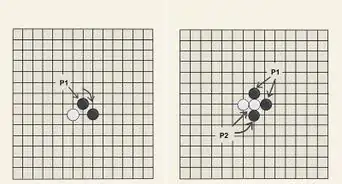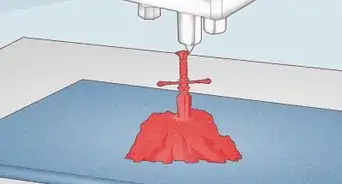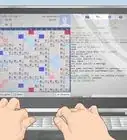This article was co-authored by wikiHow Staff. Our trained team of editors and researchers validate articles for accuracy and comprehensiveness. wikiHow's Content Management Team carefully monitors the work from our editorial staff to ensure that each article is backed by trusted research and meets our high quality standards.
This article has been viewed 25,858 times.
Learn more...
Choo choo! Ticket to Ride is a fast-paced and exciting locomotive-themed board game that you can play with up to 5 people. The object of the game is to claim railroad routes and score as many points as possible. It’s a fun, family-friendly game that’s actually pretty easy to learn. The key is to keep track of your points and strategize ways you can claim as many routes as you can.
Steps
Setup
-
1Place the Ticket to Ride board map on a table. Unfold the official Ticket to Ride board map. Place it on a table or other flat surface that has plenty of room for other players to play and for you to place cards and game pieces around it.[1]
- You must use the official board map in order to play the game.
- Ticket to Ride can be played with 2-5 people.
-
2Pass out a set of 45 Colored Train Cars to each player. Ask each person to choose a color between blue, red, green, yellow, and black. Then, have them take the set of corresponding Train Cars.[2]
- Each set should have 45 total cars plus a few extra in case some get lost. Remove the extra cars so each player has exactly 45.
Advertisement -
3Put each player’s scoring marker in the lower left corner of the board. In addition to the Train Cars, each player has a small, round scoring marker the same color as their Train Cars. Place each player’s scoring marker at the starting point on the bottom left hand corner of the board.[3]
- Every player starts the game with 0 points and uses the marker to help keep track during the game.
-
4
-
5Stack the leftover Train Car cards in the center and flip 5 cards face-up. Take the first 5 cards from the top of the deck and place them face up next to the board. Then, set the deck of remaining Train Car cards face down next to the board.[5]
- You’ll draw from the cards during the game so they need to be easily reachable for all of the players.
- The players are allowed to look at their Train Car cards as soon as they get them.
-
6Place the Continuous Path bonus card face up next to the board. There’s only 1 bonus card and it isn’t handed out until the game is over. Set it face up next to the board so you can easily find it whenever the game ends.[6]
-
7Shuffle and deal 3 Destination Ticket cards to each player. Take the deck of Destination Tickets and shuffle it really well they’re mixed up in random order and aren’t as likely to have 2 adjacent cities in a pair of cards. Pass out 3 total cards to each player face down.[7]
- The players can look at their destination cards whenever they receive them.
-
8Allow each player to choose which Destination Tickets they want to keep. Each player must keep at least 2 cards, but they can also choose to keep all 3. Place any unwanted cards back into the deck and place the deck off to the side of the board.[8]
- Keep your destination cards secret during the game.
- You’re now ready to begin a game!
Actions
-
1Get the most experienced player to go first. Ask the players which person has played the game the most. Allow them to go first and then the play will proceed clockwise around the board.[9]
- If you aren’t sure who the most experienced player is, no worries. Just have the oldest player or someone who feels comfortable going first get things started.
-
2Perform 1 of 3 possible actions during your turn. Each player can choose 1 potential action each turn. When they choose their action, their turn is over and passes to the person on their left. The three actions are:[10]
- Draw Train Car cards
- Claim a Route
- Draw Destination Ticket cards
-
3Draw 2 Train Car cards from the deck or the face up cards. If you choose to draw Train Car cards, you can take them from the face up cards next to the board, or from the top of the deck (called a blind draw). Whichever you decide, take 2 total cards and end your turn.[11]
- If you choose a face-up card, turn a replacement card face-up from the deck.
- Note: locomotive cards act as wild cards that can be substituted for any of the other train cards. But if you choose a locomotive card from the face-up cards, you can’t choose another card.
-
4Claim a Route by playing a set of cards equal to the spaces in the Route. In order to claim a Route, you need to have a matching set of Train Car cards. The set also needs to have the same number of cards as there are spaces in the Route. If you have both of these requirements, you can choose to claim a Route and place your plastic train pieces in the spaces in the Route.[12]
- Set the Train Car cards off to the side after you play them to claim a Route.
- Note: some cities are connected by double Routes. If you’re playing with 2 or 3 people, you can only claim 1 of the double Routes, and then the other one is closed.
-
5Draw 3 Destination Tickets and keep at least 1 of them. Another option is to draw Destination Tickets that you can use to connect 2 cities together to earn more points. Take 3 from the top of the deck of destination cards and take a look at them. You must keep at least 1, but you can also choose to keep all 3 if you like. Place the cards you don’t want back at the bottom of the deck.[13]
- Keep in mind that any Destination Tickets that you fail to complete will be deducted from your score!
Objectives
-
1Score points by completing the 3 possible objectives. The object of Ticket to Ride is to score as many points as you can. Each objective you accomplish gives you a certain number of points, which you can then tally up at the end of the game for a final score. The 3 objectives are:[14]
- Claim a Route between 2 adjacent cities
- Complete a Continuous Path of Routes between 2 cities listed on your Destination Tickets
- Complete the Longest Continuous Path of Routes
-
2Claim a Route between 2 adjacent cities to earn points. Connect 2 cities together by claiming the Route and occupying the spaces with your plastic Train Cars. Each Route has a different number of points you earn for completing it. Check the Route Scoring Table to see how many points you’ve earned.[15]
- For instance, a Route with 1 Train Car length earns 1 point, whereas a Route with 6 Train Cars earns 15 points.
-
3Move your scoring marker whenever you connect 2 cities. Whenever you claim a Route, add up the number of points it’s worth. Then, move your color marker along the side of the board map the number of points you’ve earned.[16]
- This is a handy way to keep track of your points during the game.
-
4Connect 2 cities listed on your Destination Tickets. Look through your hand of Destination Tickets. Strategize ways to complete a continuous path between the cities to connect them and earn the points listed on the card.[17]
- For example, if you have the “Los Angeles to New York” destination card, you can earn 21 points by connecting them with a continuous path.
- If your path is broken, you won’t earn the points for the destination card.
-
5Complete the Longest Continuous Path to earn bonus points. As you work to claim Routes and connect cities on your Destination Tickets, try to construct the longest path of Routes as you can. The player with the longest unbroken Route will win the Longest Continuous Path card at the end of the gam and earn 10 bonus points.[18]
Final Round
-
1Start the final turn when 1 player gets down to 2 or fewer trains. Each player starts the game with 45 total Train Cars, but can use them in different ways. Whenever 1 player gets down to 0, 1, or 2 Train Cars after their turn, the next turn will be the final round.[19]
- Even if the player has 0 Train Cars, they’ll still get to play 1 more round. They just won’t be able to claim any more Routes.
-
2Reveal your Destination Tickets and calculate their values. When the game is finished, each player turns over their destination cards. For each completed card, add the points to your total score. If you failed to connect the cities, then the points are subtracted from your total.[20]
- For instance, if you fail to connect your “New Orleans to Omaha” Destination Ticket, you’d have to subtract the 5 points from your total score.
-
3Give the player with the Longest Continuous Path the bonus card. Count the number of Train Cars in an unbroken path to find out which one is the longest. Award that player the Longest Continuous Path card, which adds 10 bonus points to their score.[21]
- If there’s a tie, then both players get 10 bonus points.
-
4Add together each player’s points to determine a winner. Tally up each of the player’s points including destination cards and any bonus points. Whoever has the highest score wins the game![22]
- If there’s a tie, the player that completed the most Destination Tickets is the winner. If there’s still a tie, then the player with the longest continuous path wins.
References
- ↑ https://ncdn0.daysofwonder.com/tickettoride/en/img/7201-T2R-Rules-EN-2019.pdf
- ↑ https://youtu.be/UCZ0uQxvqv8?t=28
- ↑ https://www.ultraboardgames.com/ticket-to-ride/game-rules.php
- ↑ https://ncdn0.daysofwonder.com/tickettoride/en/img/7201-T2R-Rules-EN-2019.pdf
- ↑ https://youtu.be/UCZ0uQxvqv8?t=43
- ↑ https://www.ultraboardgames.com/ticket-to-ride/game-rules.php
- ↑ https://www.ultraboardgames.com/ticket-to-ride/game-rules.php
- ↑ https://ncdn0.daysofwonder.com/tickettoride/en/img/7201-T2R-Rules-EN-2019.pdf
- ↑ https://ncdn0.daysofwonder.com/tickettoride/en/img/7201-T2R-Rules-EN-2019.pdf
- ↑ https://www.ultraboardgames.com/ticket-to-ride/game-rules.php
- ↑ https://youtu.be/UCZ0uQxvqv8?t=103
- ↑ https://www.ultraboardgames.com/ticket-to-ride/game-rules.php
- ↑ https://ncdn0.daysofwonder.com/tickettoride/en/img/7201-T2R-Rules-EN-2019.pdf
- ↑ https://ncdn0.daysofwonder.com/tickettoride/en/img/7201-T2R-Rules-EN-2019.pdf
- ↑ https://www.ultraboardgames.com/ticket-to-ride/game-rules.php
- ↑ https://youtu.be/UCZ0uQxvqv8?t=152
- ↑ https://ncdn0.daysofwonder.com/tickettoride/en/img/7201-T2R-Rules-EN-2019.pdf
- ↑ https://ncdn0.daysofwonder.com/tickettoride/en/img/7201-T2R-Rules-EN-2019.pdf
- ↑ https://www.ultraboardgames.com/ticket-to-ride/game-rules.php
- ↑ https://ncdn0.daysofwonder.com/tickettoride/en/img/7201-T2R-Rules-EN-2019.pdf
- ↑ https://www.ultraboardgames.com/ticket-to-ride/game-rules.php
- ↑ https://ncdn0.daysofwonder.com/tickettoride/en/img/7201-T2R-Rules-EN-2019.pdf
About This Article
Ticket to Ride is a fun board game for 2-5 players where players try to score the most points by building a railroad empire. To set up the game, first have each player choose which color they'd like to play as and collect the 45 railroad pieces in that color. Each player's token starts on the "1" at the rim of the board. Shuffle the train cards and deal out 4 to each player face-down. Set the remaining train cards next to the board and flip over the top 5 cards. These cards are considered part of the draw pile. Then, shuffle the destination cards and deal out 3 to each player. The player with the most travel experience starts the game, and play moves clockwise. On a player's turn, they may take 1 of 3 actions. First, they can draw 2 train cards. When drawing 2 train cards, the player chooses any of the face-up cards or draws randomly from the draw pile. When a player takes a face-up card, it should be replaced with a new card from the draw pile. There are 8 different types of train cards, each a different color. The colors correspond to the routes on the board. The multicolored locomotive cards can be used on any route on the board. Players use the train cards in their hand to complete routes on the board. A route is any line between two cities. The second possible action a player can take is claiming a route. To claim a route, a player can discard the necessary number of train cards in the color that corresponds with the route on the board and then place their train pieces on that route. Grey routes on the board can be claimed using any color set. Some routes can only be claimed once (they'll only have a single line of tracks) while others can be claimed once by one player and again by a second player (they'll have two lines of tracks). The points a route is worth depends on how long it is. You can see the points for each route length at the legend at the top of the board. When a player scores points, they move their token that number of spaces around the rim of the board. If a player completes a long route between the two cities listed on one of their destination cards, they get the number of points listed on that card at the end of the game. The third possible action a player can take on their turn is drawing 3 new destination cards. They must keep at least 1 of those destination cards. Any destination card that isn't completed at the end of the game is subtracted from that player's total score. Play continues until one player finishes their turn with less than 3 train pieces left. At that point, each player takes 1 more turn, and the player with the longest continuous route is awarded 10 points. Whoever has the most points wins the game!
